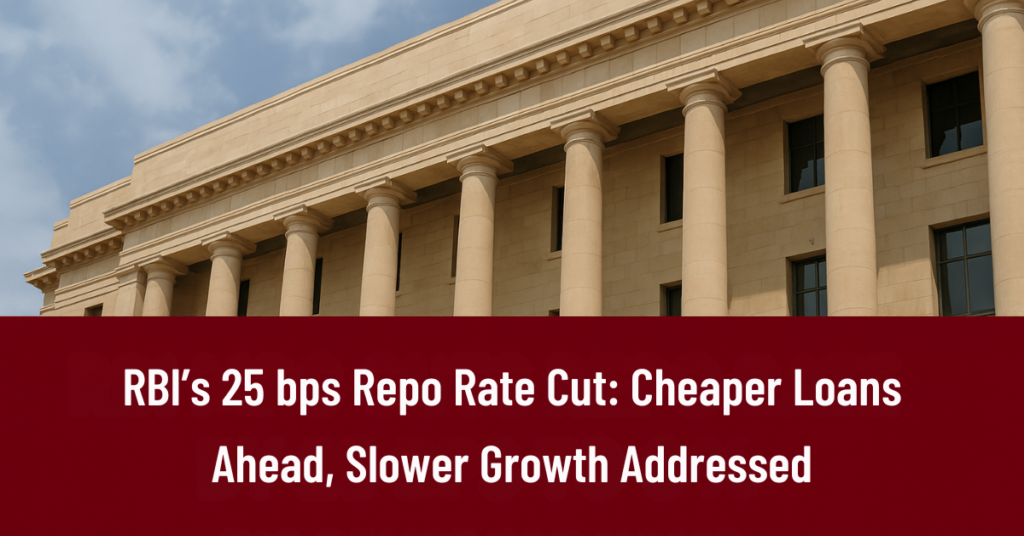
In a significant move that’s expected to ease the financial burden on borrowers, the Reserve Bank of India (RBI) has reduced the benchmark repo rate by 25 basis points, bringing it down from 6.25% to 6%. This is the second straight cut announced by the RBI this year, signaling a strong shift in its monetary policy towards supporting economic growth. The decision, taken unanimously by the Monetary Policy Committee (MPC), reflects the central bank’s growing concerns over global economic headwinds and its intent to stimulate domestic demand. Home loan borrowers, in particular, are likely to feel immediate relief, with interest rates expected to drop and EMIs potentially becoming more affordable.
The repo rate is the interest rate at which the RBI lends money to commercial banks. When this rate is cut, it becomes cheaper for banks to borrow money, which in turn allows them to lower lending rates for consumers. As a result, those with floating interest rate home loans or planning to take new loans could benefit from reduced EMIs. Additionally, the RBI also adjusted the Standard Deposit Facility (SDF) rate and the Marginal Standing Facility (MSF) rate by 25 basis points, ensuring a broader easing of borrowing costs across the financial ecosystem.
The central bank’s decision was influenced by multiple factors. One of the key reasons behind the shift was the improvement in the inflation outlook. Lower food prices and a dip in global crude oil prices have contributed to a more favorable inflation environment, giving the RBI room to prioritize growth without risking a significant rise in prices. In fact, the RBI has revised its policy stance from ‘neutral’ to ‘accommodative,’ clearly indicating a willingness to support growth even further if required. RBI Governor Sanjay Malhotra stated that in the absence of any major global uncertainties, the committee would only consider maintaining the current rate or further reducing it.
Amidst continued global uncertainties such as tariff tensions and reduced global demand, the RBI also cut its GDP growth estimate by 20 basis points. This downward revision reflects the central bank’s cautious optimism and its commitment to reviving domestic growth. To further support the economy, the RBI has already infused nearly ₹7 lakh crore into the banking system through various liquidity-enhancing measures, including bond purchases, forex swaps, and Variable Rate Repo (VRR) auctions. These actions are aimed at ensuring that banks have enough capital to lend to sectors that need a boost, including small businesses, startups, and the housing sector.
For everyday citizens, the impact of this rate cut will likely be most visible in the form of cheaper loans. Whether you’re planning to buy a home, finance a car, or take out a personal loan, this repo rate cut could result in lower interest payments. Borrowers with floating-rate loans may also see their monthly EMIs reduce over the coming months, depending on how quickly banks transmit the rate cut. However, while borrowers are likely to benefit, savers may need to reassess their strategies. As interest rates drop, fixed deposit returns are expected to decline, which might prompt investors to look toward alternative investment options such as mutual funds, bonds, or hybrid financial instruments.
The stock market is also expected to react positively to the rate cut. Lower interest rates generally boost corporate earnings by reducing the cost of borrowing, especially for capital-intensive industries such as real estate, infrastructure, and automobiles. With the RBI showing its readiness to cut rates further if required, investor sentiment may improve, driving demand in various sectors and potentially leading to a broader market rally. Sectors like housing, consumer durables, and construction could especially benefit from increased consumer spending driven by cheaper credit.
Experts believe this second repo rate cut in 2025 is part of a larger trend, as the RBI shifts its focus from inflation control to economic revival. Given the subdued global economic environment and India’s own recovery trajectory, there is a possibility of further rate cuts this year. However, future decisions will be data-driven and depend on variables such as global crude oil prices, inflationary trends, and fiscal developments. Financial analysts suggest that if inflation remains under control and crude prices stay low, the RBI may have more room to continue easing rates in the coming quarters.
For now, the RBI’s move sends a strong message: reviving growth is a top priority. With inflationary pressures easing and external challenges in play, this repo rate cut is a timely intervention to spur lending, boost consumption, and inject optimism into the financial ecosystem. Whether you’re a borrower planning your next big purchase, a saver looking for smarter investments, or a business owner exploring expansion, the RBI’s accommodative stance could help unlock new opportunities.
This policy shift also aligns with the government’s broader goal of making credit more accessible, especially in critical sectors like housing and MSMEs. With liquidity injection measures already underway and rates easing, the central bank has laid the groundwork for improved credit flow, stronger investor confidence, and a more stable economic environment in 2025.
In summary, the RBI’s decision to lower the repo rate to 6% in April 2025 brings immediate benefits to loan borrowers and sets a growth-oriented tone for the remainder of the year. It’s a move that reflects caution, optimism, and the central bank’s commitment to steering India toward a more resilient and inclusive recovery. Stay tuned for more updates on how this evolving monetary policy landscape could influence your financial plans.
Stay tuned newsdailyupdates for more updates.
Also Read
3 Lakh Indian Students in Trouble: US Plans to End OPT Work Visa
Tahira Kashyap Battles Cancer Again: Her Relapse Renews India’s Focus on Regular Mammograms
LPG Price Hike in April 2025: Domestic Cylinder Becomes Costlier by ₹50
